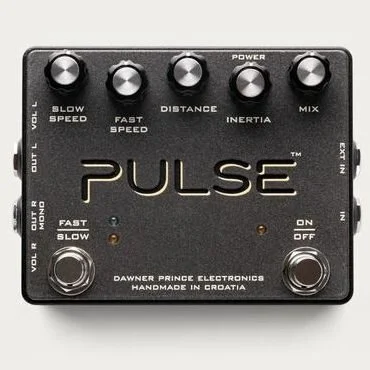Rotary Speaker (Leslie) - A Favourite Effect
As musicians, we develop affinities for different instruments, amps, techniques, sounds and even effects. In the effect realm there are thousands of offerings and if you gather a reasonable collection of those focused on their craft, you will find plenty of opinions. When presented openly, this can be really cool.
One of my favourite sounds is that of the rotating speaker as commonly defined as the Leslie. The effect is based on the Leslie design (there are more than one to be clear) which comprises two speakers, a base unit and a horn unit. The speakers don't actually rotate, enclosures around the speakers rotate, and the rotation rates are independently controllable. This produces a sound that is sometimes described as swirly or like a tremolo (volume change) or even nauseating.
The system was designed by Donald Leslie who was trying to get a Hammond organ to sound more like a pipe organ or theatre organ. He found by enclosing a speaker inside a rotating baffle he could achieve his goal, and the Leslie speaker became a popular add-on to the even more popular Hammond organ. Inevitably, guitarists tried the device and found that the liked it.
Leslie design, image courtesy Wikipedia
The more common design, known as the 122 had a single woofer and a single treble horn. This design resulted in a rather large and cumbersome unit, with a special connector to achieve a noise reducing balanced input. Other versions went to unbalanced inputs and AC motors instead of DC motors.
A Leslie 122 unit looks more like furniture than an audio effect
Original Leslies incorporate a tube amplifier and purists prefer the to later units such as Fender's Vibratone that used a solid state amplifier. The solid state units tended to hold up to touring better, but the size and weight were still issues.
The first popular foot pedal designed to approximate the Leslie sound is the UniVibe. Many musicians used the UniVibe a lot and this set the groundwork for the adoption of the Leslie sound in the guitarist's toolbox. I confess that while the UniVibe is "vintage", I prefer the sound of more modern effects. They are less noisy and provide more control.
Which brings me to today. Some pedals such as Strymon's Mobius or Eventide's H9 incorporate rotary speaker effects. They sound very good, but as rotary is a less in demand effect, multi effect units cannot do rotary and a separate effect simultaneously. This suits pedal geeks just fine as we (I am one) are quite happy with dedicated pedals. I own three dedicated rotary pedals myself as I like to experiment and build different pedal boards for different amps.
The Strymon Lex is the rotary pedal that I use in one of wet/dry rigs which puts the dry sound to one Fender Hot Rod Deluxe Mk IV and the wet sound to a different Fender Hot Rod Deluxe Mk IV. I recently started down the wet dry path with learnings from Dan and Mick over at That Pedal Show, two wonderful fellows who help me overspend on pedals and now amplifiers. The Lex is a really nice pedal with a lot of options to try out.
Strymon Lex
The Lex does a lovely job of emulating the tube overdrive you get on a real 122 in a very easy to use pedal.
My next rotary that I happily recommend is the microVent 122 from Neo Instruments.
neo Instruments microVENT 122
It is a simulator of the Leslie 122. There is also a microVENT 16 model, but I have not used it. It is similar in operation to the Strymon but with a smaller footprint. I have this on my board for my Fender Blackface Twin Reverb.
In an earlier post, I wrote about how much I love the Boonar from Dawner Prince. The Boonar does the best dedicated representation of the Binson Echorec in my opinion. I do own Strymon's Volante which is excellent but more than just an Echorec. Recently Dawner Prince made their Pulse unit available in Canada and given my happiness with the Boonar, when I could, I bought a Pulse and installed it on the board for my Blackstart Club 40 Mk II Custom, the same board that holds the Boonar. I find myself using the two together quite often for clean sounds, and with a Diamond compressor when I am pretending to have any skill at jazz.
Dawner Prince Pulse
One of the major differences between the Pulse and the other units are two separate variable rate controls for the woofer and treble horn. I like this feature and like the other pedals, this one offers the Leslie standard options for Fast and Slow.
Fast is very swirly, whereas slow is less so. The good news is that you have a large range of adjustment available with any of these pedals.
I have tried other rotary pedals and like so many things, there are a few great ones, and a lot that left me seriously underwhelmed. You should get what you like, but if you are not sure, picking any one of these three will give you pleasing tone without frustration. As with any modulation pedal, experimentation is the key to finding YOUR sound.
As none of these pedals are widely or generically available, I purchased all of them through my preferred high end pedal vendor, Electric Mojo Guitars.
Thanks for reading and until next time, peace.





